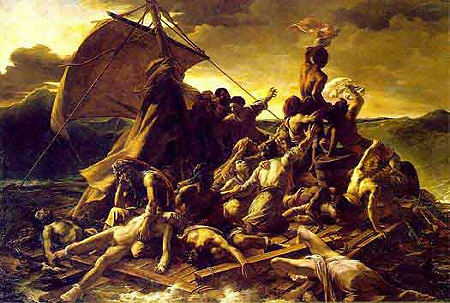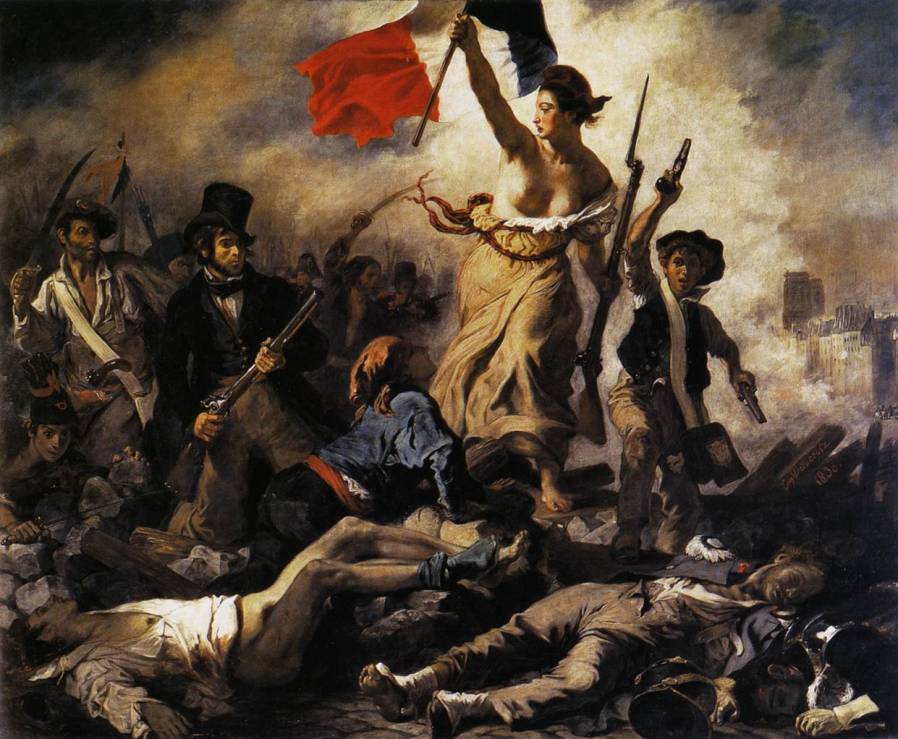The following Summary is based on quotes from Shelley Esaak's Article: Romanticism - Art History 101 Basics: 1800-1880
Read the full article by clicking on the web address below:
"Romanticism is precisely situated neither in choice of subject nor in exact truth, but in a way of feeling." -- Charles Baudelaire (1821-1867)
"When we talk about Romanticism the Movement, we aren't using the root word "romance" in the sense of hearts and flowers or infatuation. Instead, we use "romance" in the sense of glorification.
Therefore Romanticisim is the glorification of concepts and things that Romantics were fighting against. Romantic visual and literary artists glorified things ... which takes us to thorny problem number two: the "things" they glorified were hardly ever physical.
They glorified huge, complex concepts such as liberty, survival, ideals, hope, awe, heroism, despair, and the various sensations that nature evokes in humans. All of these are felt -- and felt on an individual, highly subjective level.
Aside from promoting intangible ideas, Romanticism may also be loosely defined by what it stood against. The movement championed spiritualism over science, instinct over deliberation, nature over industry, democracy over subjugation, and the rusticity over the aristocracy. Again, these are all concepts open to extremely personalized interpretation.
What Are the Key Characteristics of Romanticism?
- Emotional EmphasisThe paintings of the Romantic period were emotional powder kegs. Artists expressed as much feeling and passion as could be loaded on to a canvas. A landscape had to evoke a mood, a crowd scene had to show expressions on every face, an animal painting had to depict some, preferably majestic, trait of that animal. Even portraits were not totally straightforward representations -- the sitter would be given eyes meant to be mirrors of the soul, a smile, a grimace, or a certain tilt of the head. With little touches, the artist could portray his subject surrounded by an atmosphere of innocence, madness, virtue, loneliness, altruism or greed.
Turner, “The Fighting Téméraire tugged to her last Berth to be broken” 1839 oil painting
- Nature Can Kill You ** Please see Mrs Sturgess's note belowIf there is one prevalent theme to Romanticism, it is this: nature can change direction without warning, and we puny mortals are no match for it. You will find many, many examples of shipwrecks in Romantic paintings, for example. Shipwrecks, historically speaking, have always had high mortality rates. If you didn't drown, you stood a good chance of dying slowly of dehydration and starvation.Likewise, Romantic art had more than its fair share of blizzards, fires, thunderstorms, lightning strikes, floods, earthquakes, volcanoes, and biblical disasters. About the only natural disaster Romanticism did not try to portray was an asteroid strike. And that is probably only because no one in the early 19th-century had yet discovered the geological evidence of impact events.

Delacroix, Raft of the Medusa
**Mrs Sturgess is adding note here that the dangerous element of a Romantic painting could also come from the political environment- such as fighting for freedom in Paris.
- Current EventsIn addition to the emotionally-charged feelings one got from looking at Romantic paintings, contemporary viewers were usually quite knowledgeable of the story behind the subject matter. Why? Because the artists frequently took their inspiration from current events. For example, when Théodore Géricault unveiled his gigantic masterpiece The Raft of the Medusa(1818-19), the French public was already well acquainted with the gory details following the 1816 shipwreck of the naval frigate Méduse. Similarly, Eugène Delacroix painted Liberty Leading the People (1830) fully aware that every adult in France was already familiar with the July Revolution of 1830.Of course, not every Romantic work related to current events. For those that did, however, the benefits were a receptive, informed viewership, and increased name recognition for their creators.

Delacroix Liberty leading the People, 1830
- Lack of Unifying Style, Technique, or Subject MatterRomanticism wasn't like Rococo art, in which fashionable, attractive people engaged in fashionable, attractive pastimes while courtly love lurked around every corner -- and all of these goings-on were captured in a light-hearted, whimsical style. Instead, Romanticism included William Blake's disquieting apparition The Ghost of a Flea (1819-20), sitting in close chronological proximity to John Constable's comfortably rural landscape The Hay Wain(1821). Pick a mood, any mood, and there was some Romantic artist that conveyed it on canvas.Romanticism wasn't like Impressionism, where everyone concentrated on painting the effects of light using loose brushwork. Romantic art ranged from the smooth-as-glass, highly-detailed, monumental canvas Death of Sardanapalus (1827) by Eugène Delacroix, to J. M. W. Turner's indistinct watercolor washes in The Lake of Zug (1843), and everything in between. Technique was all over the map; execution was completely up to the artist.Romanticism wasn't like Dada, whose artists were making specific statements about WWI and/or the pretentious absurdities of the Art World. Romantic artists were apt to make statements about anything (or nothing), dependent on how an individual artist felt about any given topic on any given day. Francisco de Goya's work explored madness and oppression, while Caspar David Friedrich found endless inspiration in moonlight and fog. The will of the Romantic artist had the final say on subject matter.
Influences of Romanticism
The most direct influence of Romanticism was Neoclassicism, but there is a twist to this. Romanticism was a type of reaction to Neoclassicism, in that Romantic artists found the rational, mathematical, reasoned elements of "classical" art (i.e.: the art of Ancient Greece and Rome, by way of the Renaissance) too confining. Not that they didn't borrow heavily from it when it came to things like perspective, proportions, and symmetry. No, the Romantics kept those parts. It was just that they ventured beyond the prevailing Neoclassic sense of calm rationalism to inject a heaping helping of drama.
This Time Cover From 2009 Looks like a Liberty Leading the People Moment.

No comments:
Post a Comment